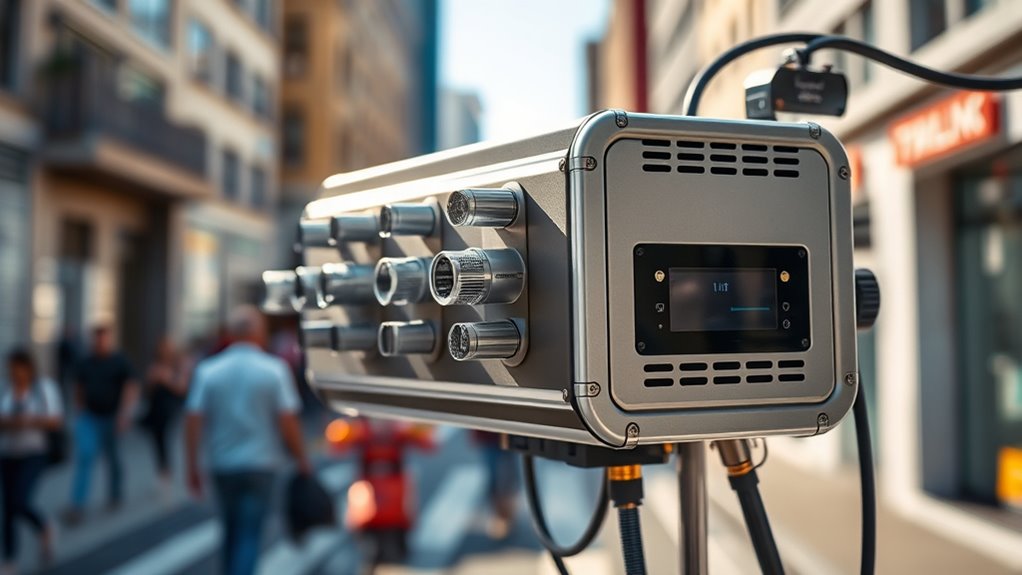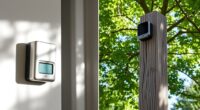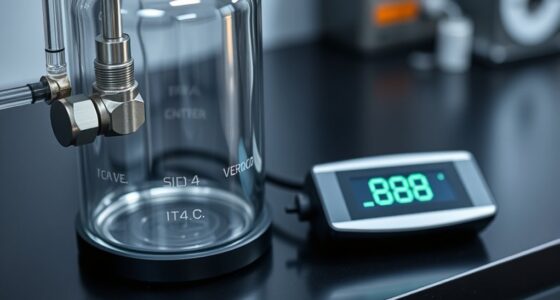Mobile air quality monitoring units give you flexible, real-time data on urban pollution, helping you spot localized issues quickly and efficiently. They can be deployed in specific areas like highways or construction sites, providing insights that static stations might miss. However, you need to keep up with regular calibration and maintenance to make certain of accurate results. Want to discover more about how these units can improve air quality management? Keep exploring for detailed insights.
Key Takeaways
- Mobile units provide real-time, localized air quality data, capturing pollution hotspots missed by static stations.
- They enhance data accuracy through regular calibration, ensuring reliable measurements over time.
- These units enable flexible deployment in specific areas like high-traffic zones and industrial sites.
- Challenges include maintenance requirements, battery life limitations, and the need for robust digital infrastructure.
- Costs and logistical complexities may restrict widespread adoption, especially in resource-limited regions.

Have you ever wondered how cities track air pollution in real time? Mobile air quality monitoring units make this possible by providing dynamic, on-the-go data that static stations can’t always capture. These units rely heavily on sensor calibration to guarantee accuracy. Proper calibration is essential because sensors can drift over time, leading to unreliable readings. Regular calibration against known standards keeps data trustworthy and ensures that the information you receive reflects actual pollution levels. Once calibrated, these sensors feed data into integrated systems, creating a thorough picture of air quality across different areas. Data integration allows multiple sensors to work together seamlessly, combining their readings into a unified dataset. This process involves standardizing data formats, correcting for sensor biases, and filtering out noise, which helps produce a clear, accurate view of pollution trends. When data from various sources is integrated effectively, city officials can identify pollution hotspots, track changes over time, and respond quickly to air quality issues. The mobility of these units is a significant advantage, as they can be deployed in specific locations where static stations might miss localized pollution spikes. This flexibility helps monitor air quality near construction sites, busy highways, or industrial zones, providing real-time insights that enable timely interventions. However, despite these benefits, there are limitations. Sensor calibration isn’t a one-time fix; it requires ongoing maintenance and frequent recalibration to maintain accuracy, which can be resource-intensive. Data integration, while powerful, depends heavily on robust digital infrastructure and skilled personnel, making it challenging for some cities to implement effectively. Additionally, mobile units might not cover vast areas consistently, especially in large or complex urban environments, potentially missing critical pollution events. Battery life and data transmission also pose challenges; units need reliable power sources and wireless connections to transmit data without interruption. Furthermore, the cost of deploying and maintaining these units can be significant, which might limit their widespread use in smaller cities or developing regions. Despite these hurdles, mobile air quality monitoring units are a valuable tool for enhancing our understanding of urban pollution. They provide actionable data that can inform policies, public health advisories, and pollution control measures. When properly calibrated and integrated within a broader monitoring network, they offer a flexible, real-time glimpse into air quality that static stations alone can’t provide. Advances in sensor stability and calibration techniques**** will continue to improve the reliability of these units, making them more accessible and effective for urban communities.
Frequently Asked Questions
How Accurate Are Mobile Air Quality Monitors Compared to Stationary Sensors?
Mobile air quality monitors can be quite accurate, but their reliability depends on proper sensor calibration and maintenance. Since they move through different environments, they might experience variability, affecting data reliability. You should regularly calibrate sensors to guarantee consistent results. While stationary sensors often provide more stable data over time, mobile units offer flexibility and localized readings, making them valuable tools when used with proper calibration and data validation.
What Are the Typical Costs Associated With Deploying Mobile Air Quality Units?
Deploying mobile air quality units can be a costly endeavor, often ranging from $20,000 to $100,000 per unit, depending on features. Think of it as investing in a high-tech detective tool—valuable but pricey. Conducting a detailed cost analysis helps you understand expenses, while exploring funding options like grants or partnerships can alleviate the financial burden. This way, you ensure your air quality monitoring efforts are both effective and sustainable.
How Long Can a Mobile Monitoring Unit Operate on a Single Charge?
You can expect a mobile air quality monitoring unit to operate for about 6 to 12 hours on a single charge, depending on the battery life and usage. The charging time typically ranges from 2 to 4 hours, so plan accordingly for extended monitoring periods. Keep in mind that high-performance sensors and continuous data collection may reduce battery life, making it essential to monitor battery levels and plan charging breaks during deployment.
Are Mobile Units Suitable for Monitoring Indoor Air Quality?
Mobile units aren’t ideal for indoor air quality monitoring because indoor feasibility can be limited by space and access issues. You might find they impact occupants if they’re intrusive or noisy, which can skew results or cause discomfort. While they offer flexibility outdoors, for indoor environments, stationary or specialized indoor monitors often provide more accurate, consistent data without disrupting occupants. Consider these factors to choose the best monitoring approach for indoor air quality.
How Do Weather Conditions Affect Mobile Air Quality Data Collection?
Did you know that weather impact can cause air quality readings to fluctuate by up to 30%? Seasonal variation considerably influences mobile air quality data collection, as wind, humidity, and temperature change throughout the year. These factors can skew measurements, making it harder to get consistent data. You’ll need to account for weather conditions to guarantee accurate, reliable results, especially during extreme weather events or seasonal shifts.
Conclusion
Mobile air quality monitoring units are like sentinels patrolling your environment, offering real-time insights that can protect your health. While they provide flexibility and immediate data, they also face limitations like coverage gaps and maintenance needs. By understanding both their strengths and weaknesses, you can better harness these tools to breathe cleaner air. Remember, these units are your frontline allies—if used wisely, they can turn the tide in your fight for healthier surroundings.










